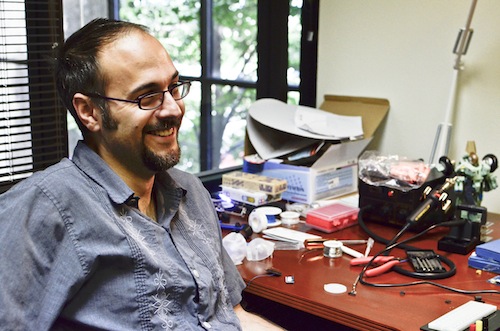EEWeb sits down with Mike Hord
One of SparkFun's newest engineers is interviewed over at EEWeb.
Recently, Mike Hord - one of the SparkFun engineers - sat down with EEWeb to talk a little shop. They posted the interview on their website and we wanted to share some of it here. Here is part of the exchange:
How did you get into electronics/engineering and when did you start?
I came to electronics fairly late in the game. It was my senior year of high school before it occurred to me that I could make a career out of it. My high school physics teacher told us some stories about the fun stuff the electrical engineering students he knew in college had made, and that sealed the deal. That is not to say I didn’t have interest in it in the past—as a child I took apart a ridiculous number of electronic gadgets, some of which my parents would rather I hadn’t.
After high school I went on to study engineering at North Dakota State University. For me it was a great decision because of its engineering program, which is very well-respected especially in the Upper Midwest region.
What are your favorite hardware tools that you use?
My senses. I start out every troubleshooting session with four of my senses: does anything look wrong (size, shape, color), does anything feel wrong (hotter or colder than expected), does anything sound wrong (clicking, buzzing, whining), and what about smell (burning, unnatural odors)?
The best part is that setup and calibration time for these tools is zero. I always know where they are, and they’re pretty easy to use.
What are your favorite software tools that you use?
LTSpice from Linear Tech is a staple of my design work. Also, Python is great for throwing together quick tools to automate boring tasks.
What is the hardest/trickiest bug you have ever fixed?
I’ve had several involving defective component populations failing in the field. These are the worst, because that’s always the last thing you consider because it tends to be fairly unlikely, and the average engineer doesn’t have the tools to differentiate between parts failing because of a design defect and parts failing because of a component defect. Sometimes even the experts can’t find direct evidence of it and you end up having to rule out all the competing theories—that’s a very unsatisfying way to end a problem-solving arc.
You can read the rest of the article here. How would you answer some of these questions? What are your favorite hardware tools and what is the trickiest bug you've ever fixed? How did you get into electronics? We've found some of our most enlightening moments in embedded electronics aren't found in a classroom, but rather through networking with other like-minded people. Tell us your story!







